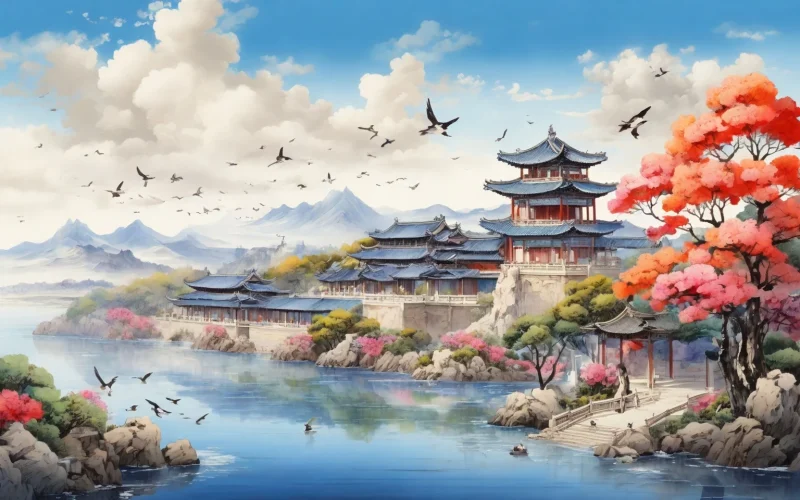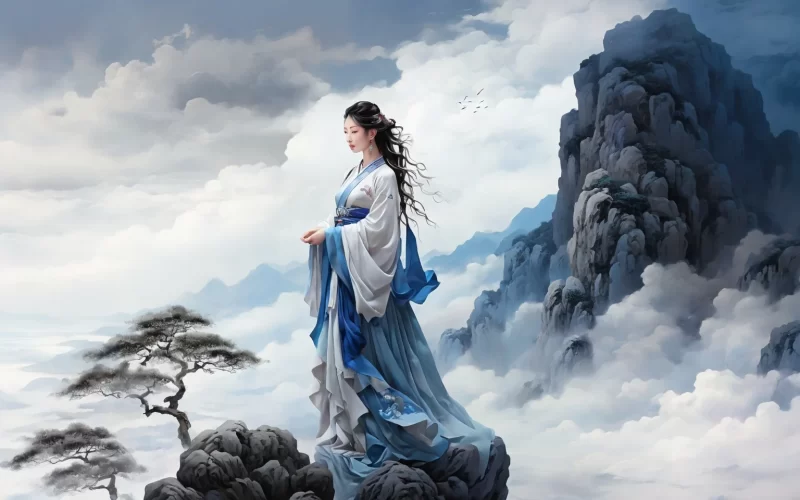The swallows' twitter seems to grieve over the lost spring;
To dust have returned palace flowers on the wing.
Since the overthrown dynasty closed its splendid scene,
They have come many times but nobody is seen.
Original Poem
「隋宫燕」
李益
燕语如伤旧国春,宫花一落已成尘。
自从一闭风光后,几度飞来不见人。
Interpretation
Composed during the transition between the Sui and Tang dynasties, this poem laments the decline and fall of the Sui Empire. Emperor Yang of Sui indulged in extravagance, frequently touring Jiangdu (modern Yangzhou), exhausting national resources and ultimately leading to the dynasty's collapse. The once-magnificent Sui palaces now lie in ruins, bearing silent witness to historical rise and fall. Through swallows' murmurs and palace flowers' decay, the poet vividly depicts the transience of glory, channeling reflections on life's impermanence.
First Couplet: "燕语如伤旧国春,宫花一落已成尘。"
Yàn yǔ rú shāng jiù guó chūn, gōng huā yī luò yǐ chéng chén.
Swallows chatter as if mourning the lost kingdom's spring / Palace blossoms fall once, turned to dust without lingering
The poet personifies swallows' calls into historical elegies, imbuing nature with human nostalgia. The palace flowers—once symbols of imperial splendor—now crumble instantly to dust, mirroring the Sui dynasty's meteoric rise and catastrophic fall. This imagery embodies both political transience and existential impermanence, creating an atmosphere of profound melancholy.
Second Couplet: "自从一闭风光后,几度飞来不见人。"
Zì cóng yī bì fēng guāng hòu, jǐ dù fēi lái bú jiàn rén.
Since grandeur sealed behind closed gates / Swallows return yearly to find empty estates
"Grandeur" (风光) symbolizes the Sui court's vanished opulence, while "sealed" (闭) marks its irreversible decline. The swallows' cyclical returns—now met with abandoned courtyards—poignantly measure time's passage and history's indifference. These migratory birds, traditionally associated with loyalty and homecoming, become ironic witnesses to imperial oblivion, their nest-building rituals contrasting with human impermanence.
Holistic Appreciation
The poem contrasts the Sui palace's past glory with present desolation through swallows' perspectives and floral decay. As seasonal migrants, swallows serve as living chronometers, their annual returns highlighting historical rupture. This "microcosmic" approach—using nature's cycles to mirror dynastic collapse—creates expansive philosophical depth.
Rather than directly condemning imperial folly, the poet crafts an elegiac atmosphere through symbolic interplay. The swallows' mournful songs become history's echo chamber, while the flowers' ephemeral beauty mirrors political vanity. Such indirect critique allows readers to intuit historical lessons through sensory immersion rather than didacticism.
Artistic Merits
- Anthropomorphic Nuance: Swallows "mourning" and flowers "crumbling" transform scenery into emotional narrative.
- Reality-Imagination Fusion: Physical ruins merge with symbolic avian lamentations, blending documentary realism with poetic license.
- Dramatic Juxtaposition: The vibrant past versus desolate present amplifies historical pathos through swallows' futile homecomings.
- Subtle Allusiveness: Unspoken critiques of tyranny linger beneath natural imagery, inviting layered interpretation.
Insights
This meditation on Sui's collapse transcends its era to voice universal truths about power and impermanence. The swallows' empty nests and vanished blossoms warn against hubris—whether imperial or personal—in chasing ephemeral glory. By framing historical judgment through nature's indifference, the poem suggests that all human endeavors ultimately yield to time's erosion, yet paradoxically, art (like these verses) may preserve memory beyond material decay.
The work also resonates with modern ecological consciousness: the swallows, persistent despite human folly, symbolize nature's endurance amidst civilizational collapse. In an age of climate crisis and political upheaval, this Tang-era vision reminds us that while empires fade, the swallows will keep returning—to ruins transformed into new ecosystems.
Poem translator
Xu Yuanchong (许渊冲)
About the poet

Li Yi (李益), 748 - 829 AD, a native of Wuwei in Gansu Province, was one of the “Ten Scholarly Men of the Dali Dynasty”, and is best known for his works on the border and the Plateau, especially for his seven-character stanzas. His poems had a harmonious rhythm and were sung by musicians at that time.












